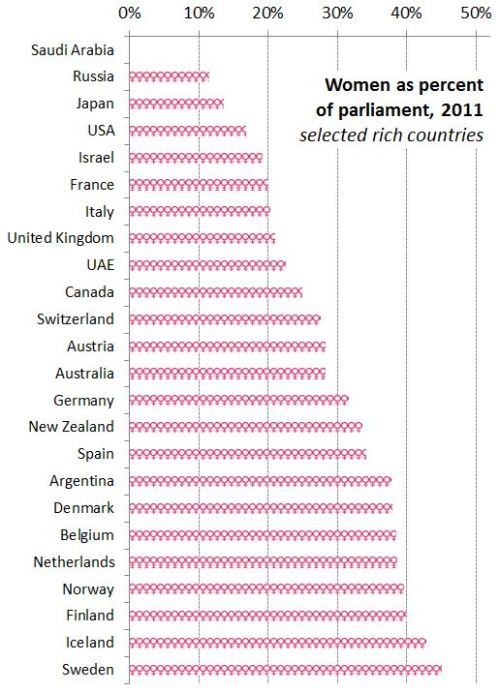Cross-posted at Family Inequality.
I have criticized sloppy statistical work by some international feminist organizations, so I’m glad to have a chance to point out a useful new report and website.
The Progress of the World’s Women is from the United Nations Entity for Gender Equality and the Empowerment of Women. The full-blown site has an executive summary, a long report, and a statistics index page with a download of the complete spreadsheet. I selected a few of the interesting graphics.
Skewed sex ratios (which I’ve written about here and here) are in the news, with the publication of Unnatural Selection, by Mara Hvistendahl. The report shows some of the countries with the most skewed sex ratios, reflecting the practice of parents aborting female fetuses (Vietnam and Taiwan should be in there, too). With the exception of Korea, they’ve all gotten more skewed since the 1990s, when ultrasounds became more widely available, allowing parents to find out the sex of the fetus early in the pregnancy.
 The most egregious inequality between women of the world is probably in maternal mortality. This chart shows, for example, that the chance of a woman dying during pregnancy or birth is about
The most egregious inequality between women of the world is probably in maternal mortality. This chart shows, for example, that the chance of a woman dying during pregnancy or birth is about 100- 39-times higher in Africa than Europe. The chart also shows how many of those deaths are from unsafe abortions.
Finally, I made this one myself, showing women as a percentage of parliament in most of the world’s rich countries (the spreadsheet has the whole list). The USA, with 90 women out of 535 members of Congress, comes in at 17%.

The report focuses on law and justice issues, including rape and violence against women, as well as reparations, property rights, and judicial reform. They boil down their conclusions to: “Ten proven approaches to make justice systems work for women“:
1. Support women’s legal organizations
2. Support one-stop shops and specialized services to reduce attrition in the justice chain [that refers to rape cases, for example, not making their way from charge to conviction -pnc]
3. Implement gender-sensitive law reform
4. Use quotas to boost the number of women legislators
5. Put women on the front line of law enforcement
6. Train judges and monitor decisions
7. Increase women’s access to courts and truth commissions in conflict and post-conflict contexts.
8. Implement gender-responsive reparations programmes
9. Invest in women’s access to justice
10. Put gender equality at the heart of the Millennium Development Goals


Comments 25
Umlud — July 7, 2011
While the data are interesting to look through, the presented graphs are troubling to me, because the first and last don't show the same countries. A message that one can get would be, "Girls are selected against in poor/non-Western countries. Look at how much better things are in rich/Western countries." (Notice that while South Korea showed up on the sex-selection graph -- the only OECD country to do so -- it didn't show up in Philip's "Selected Rich Countries" graph. Neither did China -- the 2nd richest by GDP.)
So, for the sake of completeness, I looked up the stats for female representation in the countries in the first graph:
Armenia: 9.2%
Azerbaijan: 16.0%
China: 21.3%
Georgia: 6.5%
India: 10.7%
South Korea: 14.7%
So, South Korea is slightly ahead of Japan's 13.6%, India is slightly below Russia's 11.5%, and China's well ahead of the US's 16.8%, and looks a little closer to France (20.0%), Italy (20.3%), and United Kingdom (21.0%). Armenia and Georgia are below 10%, but are better (if only just slightly) than 19 other countries on the UN list.
While I understand why Philip may have omitted Armenia, Azerbaijan, Georgia, and India from his graph of "selected rich countries", my questions to him is, "Why explicitly exclude South Korea and China from your graph of 'selected rich countries'?"
Finally, the UN's fact spreadsheet unfortunately didn't have additional longitudinal info about sex ratios for countries other than the ones in the graph above (or at least I didn't find it). It would be interesting to look whether other countries stay relatively close to the normal 102-106 boys per 100 girls ratio that the UN cites as "biologically normal".
Yrro Simyarin — July 7, 2011
"4. Use quotas to boost the number of women legislators"
That is one of the most un-democratic and bigoted recommendations I have ever heard.
Give women the right to vote, and if *they* decide that what is in someone's pants is more important than what political ideas they bring to the table, let them elect them.
It is neither in the best interests of feminism nor equality in general to force ideas on women.
Quota voor vrouwen in topfunctie: Europa dreigt met dwang - Pagina 4 - 9lives - Games Forum — July 7, 2011
[...] Ik discussieer niet mee want ik maak mij veel te kwaad in internet-discussies Maar ik moest vandaag aan dit topic denken toen ik dit las, misschien eens interessant om door te nemen? Global women [...]